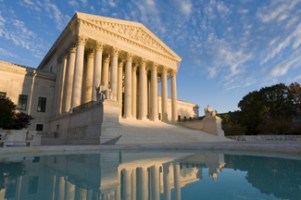SCOTUS revives pregnancy bias case; Scalia says majority used 'Supreme Wand' to create test

Image from Shutterstock.
A United Parcel Service employee who claimed the company failed to accommodate her 2006 pregnancy by giving her light duty will get a chance to pursue her claim as a result of a U.S. Supreme Court decision on Tuesday.
The Supreme Court ruled on behalf of Peggy Young, though it rejected her suggested test for determining whether UPS violated the Pregnancy Discrimination Act. Justice Stephen G. Breyer wrote the majority opinion (PDF), joined by Chief Justice John G. Roberts Jr. and Justices Ruth Bader Ginsburg, Sonia Sotomayor and Elena Kagan. Justice Samuel A. Alito Jr. concurred in the judgment.
The Pregnancy Discrimination Act requires employers to treat pregnant women the same as nonpregnant workers who are “similar in their ability or inability to work.” Young had asserted UPS violated the law because it treated her differently than other UPS workers given accommodations, including workers who were disabled or who were injured on the job, and drivers who lost Department of Transportation certifications.
Young urged the court to adopt this test: A company that accommodates a subset of workers with disabling conditions must give the same treatment to pregnant women who are similar in their ability to work.
Breyer, however, said that test seems to grant pregnant workers a “most-favored-nation” status, requiring accommodations for pregnant women even when the other accommodated workers are older than 55, work in particularly hazardous jobs, or are particularly needed in the workplace. Breyer also rejected a test urged by the company.
Instead, Breyer said, a pregnant worker who seeks to show disparate treatment must make out a prima facie case by showing the employer refused her accommodation while accommodating others similar in their ability or inability to work. The employer then has a chance to prove it had legitimate, nondiscriminatory reasons for denying accommodation—though the extra expense or inconvenience would normally be an inadequate reason. The plaintiff then has the opportunity to show the proffered reasons are pretextual.
A plaintiff could get her case to a jury with evidence that the employer accommodates a large percentage of nonpregnant workers while failing to accommodate a large percentage of pregnant workers, Breyer said. Young’s evidence was sufficient to create an issue in her prima facie case, and her claim should be reconsidered on remand, Breyer concluded.
Justice Antonin Scalia dissented in an opinion joined by Justices Anthony M. Kennedy and Clarence Thomas. “Faced with two conceivable readings of the Pregnancy Discrimination Act, the court chooses neither,” Scalia wrote. “It crafts instead a new law that is splendidly unconnected with the text and even the legislative history of the act. …
“Dissatisfied with the only two readings that the words of the same-treatment clause could possibly bear, the court decides that the clause means something in-between. It takes only a couple of waves of the Supreme Wand to produce the desired result. Poof!”
Related articles:
ABAJournal.com: “SCOTUS considers UPS worker’s pregnancy bias suit; were accommodations required?”
ABA Journal: “Court to weigh whether employers must accommodate pregnant workers with the same limits as others”
Updated at 3 p.m. to add missing word.



